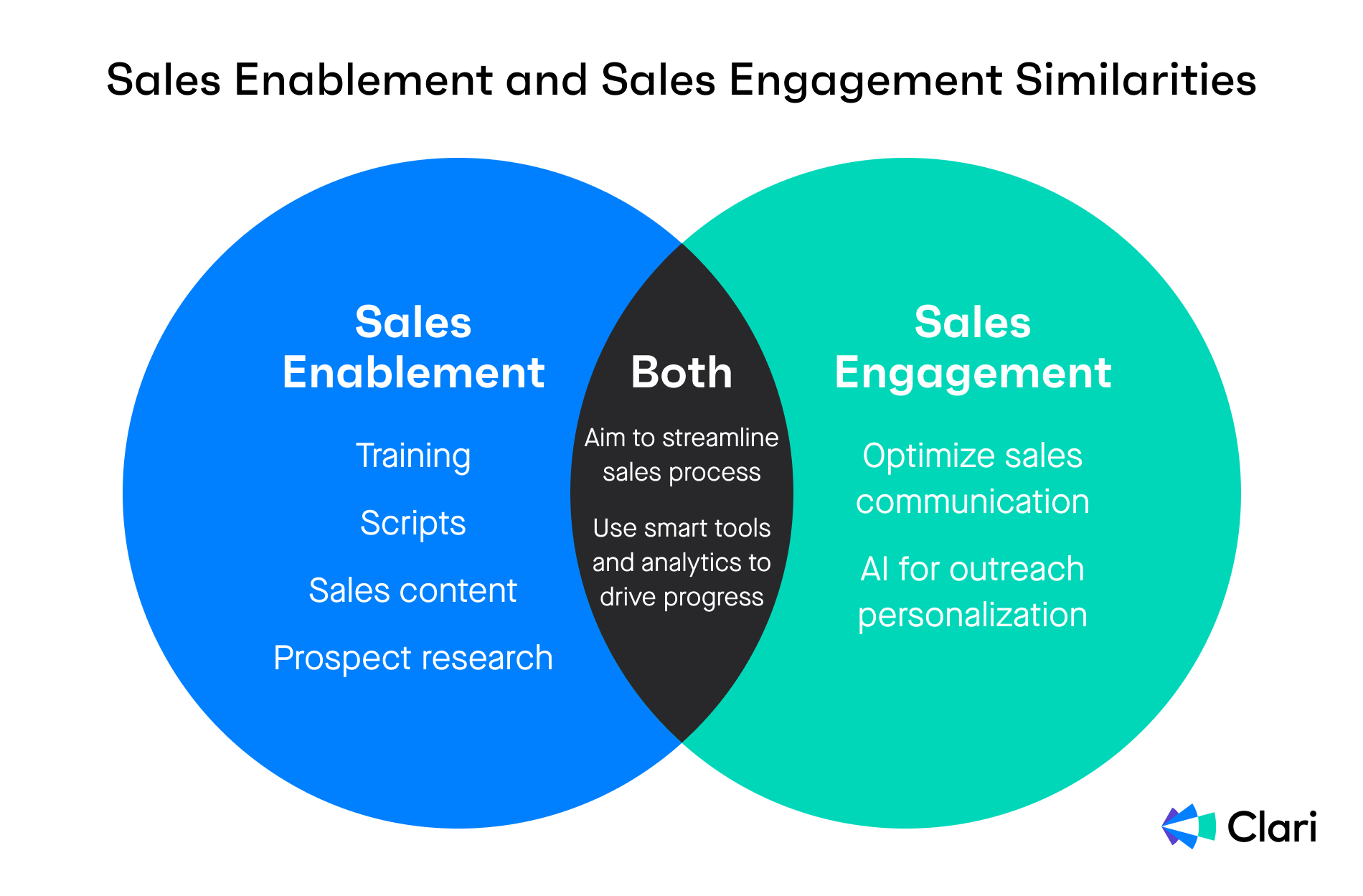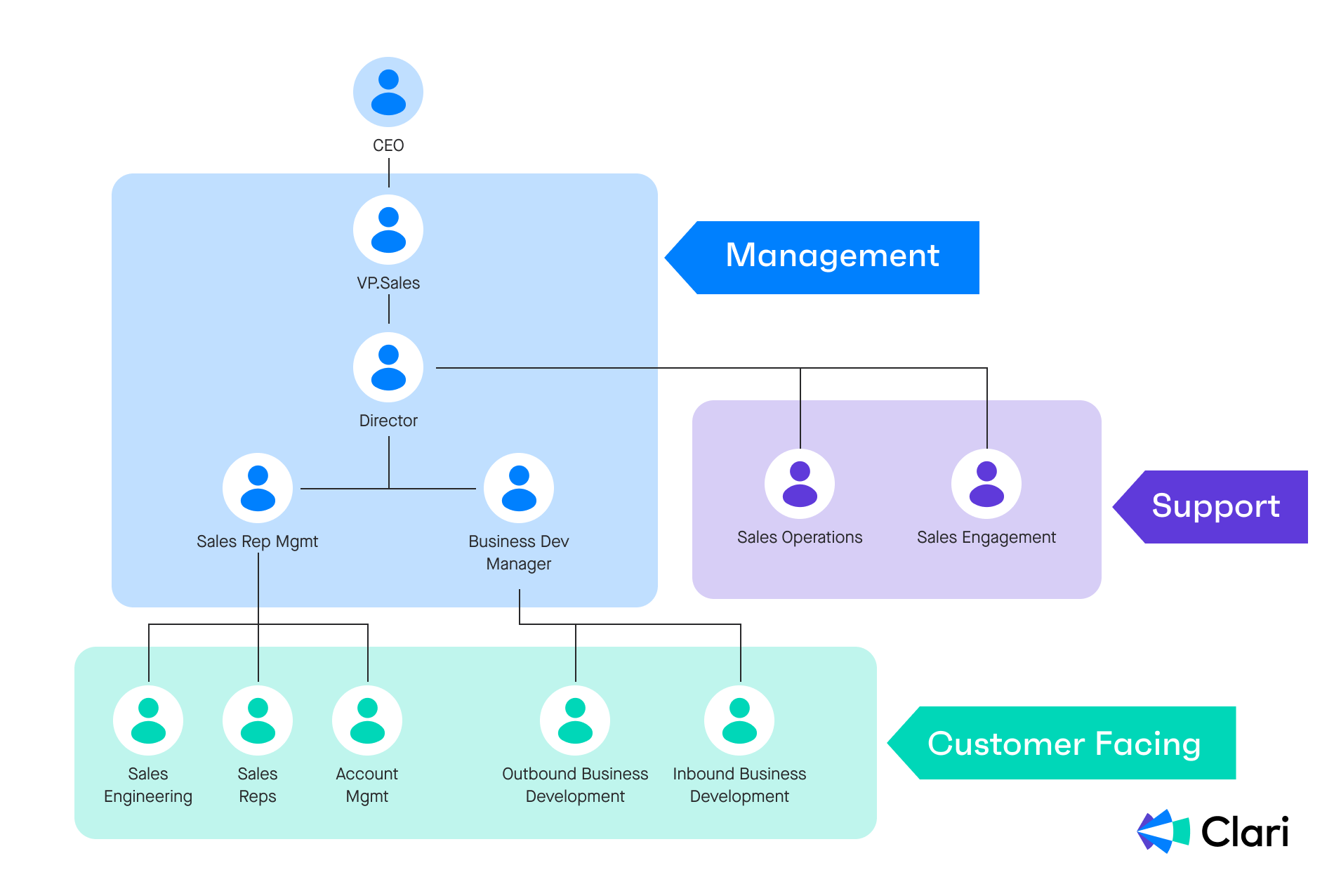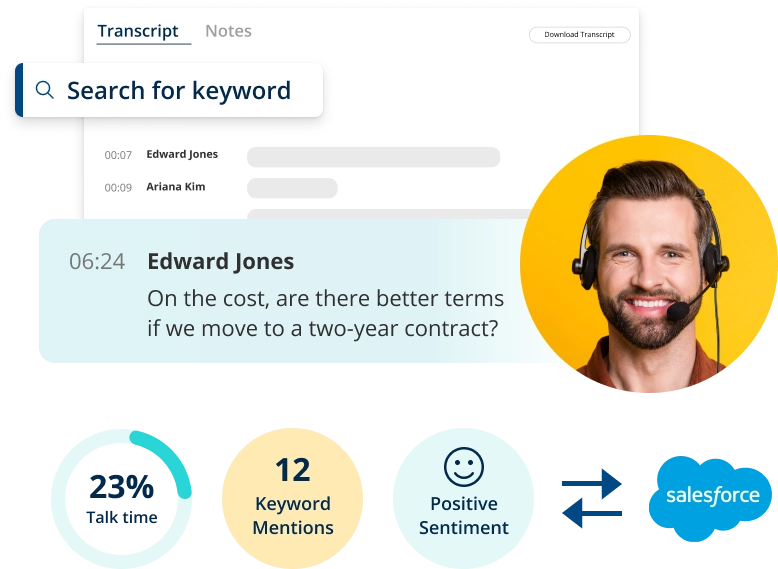
New sales technologies mean new opportunities to help your sales team perform at their best. Sales enablement and sales engagement can help lay the foundation for high-performing reps.
Many think these terms are interchangeable. However, different approaches optimize different aspects of the sales process.
This guide will explain the similarities and differences between sales enablement vs. sales engagement. You’ll explore examples, strategies, recommended tools, and more.
Table of content:
- What is sales enablement?
- What is sales engagement?
- What are the similarities between sales enablement and sales engagement?
- What are the differences between sales enablement and sales engagement?
- How do sales enablement and sales engagement work together?
- Why have both sales enablement and sales engagement strategies?
- How to effectively implement sales enablement and sales engagement strategies
- Sales enablement tools vs. sales engagement platforms
- How to know which tools are right for your business
- What’s next?
What is sales enablement?
Sales enablement gives your sales representatives the tools, information, and framework they need to succeed. You can think of it as the supporting organization around a sports team. You deal with research, strategy, and creating systems to help your reps perform at their best.
Sales enablement includes actions like:
- Creating sales playbooks and sales scripts to help your reps close more deals
- Giving sales reps access to crucial prospect data
- Finding the right sales tools for your reps
Combined, these efforts empower your sales reps to handle prospect interactions better. They give the right case study to the right prospect and use more relevant arguments.
What is sales engagement?
Sales engagement is the process of optimizing how your sales reps interact with prospects on all sales channels. You focus on improving your reps' timing, messaging, and prioritizing to boost engagement.
Sales engagement actions and tools include:
- Using smart outreach software to help your SDRs connect with the right potential customers
- Measuring the impact of different outreach approaches
- Using AI-powered tools to figure out which deals to focus on and when to follow up
Sales engagement is about helping your reps optimize their interaction with prospects. A good engagement program helps your reps navigate the sales journey more efficiently and close more deals.
What are the similarities between sales enablement and sales engagement?
Sales enablement and sales engagement share crucial goals and try to change the same people: your sales reps.

The approach is also similar, focusing on tools and systems to help reps at scale.
Both aim to streamline the process and systems around reps
Sales enablement and engagement aim to improve the larger sales process and systems around the reps. They are not concerned with direct sales coaching.
They also focus on similar areas, but the implementation of the solutions is different. For example:
- The sales enablement team might create email templates to help reps craft better pitches.
- A sales rep can use sales engagement software to send automated email campaigns.
Both help reps adapt to changing environments and buyer needs
One of the key goals of both sales engagement and enablement is to help reps adapt to the rapidly changing business world
And this is crucial. According to Gartner, 83% of sales leaders said their sellers struggle to adapt to changing customer needs and expectations.
You can craft various sales plays that appeal to different personas in sales enablement. You can then use engagement software to analyze which persona aligns best with each prospect.
Both focus on using tools and analytics data for lasting change
Instead of going by “experience” or “hunches,” modern sales engagement takes a data-centric approach. The same is true for sales engagement.
You use analytics platforms and automations to optimize sales communications.
What are the differences between sales enablement and sales engagement?
The main differences between sales enablement and engagement are their focus area and timing.
- Sales enablement focuses on optimizing the training, sales content, and systems. There’s no direct intervention in an active sales process.
- Sales engagement uses tools to directly impact sales communication. AI-powered tools will suggest when to reach out or even automatically send personalized messages.
Sales enablement happens before your reps start to sell. You place the systems, data, and content they need to get their job done.
Sales engagement happens during the selling. Your reps use software to automate outreach, track email interactions, and better time their sales activities.
Further reading: Differences between sales engagement vs. sales readiness
How do sales enablement and sales engagement work together?
Sales engagement can fall under sales enablement, depending on how you structure your sales organization.
If you don’t have a dedicated sales enablement team, both responsibilities go to sales management. (But we’d recommend having at least a sales enablement manager.)
In a larger enterprise, the sales org might look something like this:

Both disciplines are strongly related to implementation sales operations but have a narrower focus.
This means that an improvement in one area often leads to boosts in another:
- Improved prospect data from sales enablement also boosts sales engagement.
- Sales engagement platforms can help your reps better follow sales plays at scales.
- Sales engagement metrics help guide your sales enablement efforts.
Why have both sales enablement and sales engagement strategies?
While you may want to put engagement under the enablement umbrella, it’s not a good idea to treat it that way. Because engagement is such an important aspect, don’t make it a side note in your enablement strategy.
Develop a separate sales engagement strategy where you can dive deep into outreach strategies, messaging optimization, and more.
Separate strategies are easier to implement and track
Enablement and engagement have completely different ideal North Star metrics. In engagement efforts, you want to focus on prospects' response rates. The narrow focus helps you quickly test different messages and sales strategies.
In enablement, you focus more on each individual rep:
- How quickly new reps start closing deals (time to effectiveness)
- How often reps use your sales content (content usage)
- How effective reps are on average
- How satisfied your reps are with their job
The goal of sales enablement is to help reps perform at their best. Sales engagement uses data and workflow automation to optimize each buyer interaction.
The difference in goals, metrics, and approaches merit individual strategies.
Assign each to different stakeholders to avoid overwhelming them
You also want to assign these responsibilities to separate managers. This will help hold your team accountable to KPIs across both areas without a single manager getting burned out.
By separating it into two separate stakeholders, you ensure follow-through in both areas.
How to effectively implement sales enablement and sales engagement strategies
It’s not a good idea to merge sales enablement and engagement strategies. To be effective, you should create, follow, and handle them separately.
Identify clear goals and KPIs to measure progress
Start by determining each strategy's key performance indicators (KPIs).
- Common enablement KPIs are sales content utilization and win rate by sales rep. Find the metrics that matter most for your sales enablement strategy.
- For sales engagement, you might measure response rates for outreach and, ultimately, the deal win rate or quota attainment. Consider your priorities and the areas where your reps struggle most.
Invest in the right platforms and tools
Sales enablement is impossible without the right tools in place. It doesn’t matter if you have written sales scripts and other content if your reps can’t find it when they need it.
The same goes for sales engagement. Without a robust engagement platform, you don’t have reliable metrics. You have to go by your sales rep’s self-evaluations and bottom-line metrics.
Sure, sales managers can sit in on sales calls now and then. But that’s very time-intensive. The right tools can free up your sales leaders’ time and energy to focus on the big picture.
Introduce new tools gradually and properly onboard your sales reps
Don’t try to onboard too many new tools at once. This will only lead to overwhelm among your sales reps. Sellers who feel overwhelmed by technology are 43% less likely to meet quotas than non-overwhelmed sellers.

Introduce new tools gradually, based on their value to your bottom line. If your sales team struggles with prospecting, start with sales engagement.
Sales enablement tools vs. sales engagement platforms
Thanks to developments in AI, sales enablement and sales engagement software are getting smarter. Let’s take a closer look at how different tools can help your sales team.
Sales enablement platforms and tools
Sales enablement teams can leverage different tools with a wide range of features:
- Sales content tools improve the accessibility of sales content. They also help with personalization and analytics. These tools are often called sales enablement platforms.
- Sales training platforms help you onboard staff and train them in your methods.
- Prospect data research platforms can help your reps get a better handle on their prospects.
The best combination of tools depends on the needs of your sales team and company. Larger teams with high turnover rates may want to focus on sales content and training. A smaller team might prioritize higher-quality prospect data.
Sales engagement platforms
For sales engagement, all-in-one platforms are more common. For example, Groove can:
- Suggest upselling opportunities in real time.
- Automatically personalize outreach (with smart follow-up messages).
- Use conversational intelligence to break down where things went right (or wrong) in sales calls.

Groove helps your sellers without needing to learn a new tool. It interacts with them where they already work—email, CRM, or calendar.
It also gives your sales managers reliable data points to guide their coaching efforts. You can see exactly where reps go wrong in specific sales conversations.
This boosts the impact of training and enablement efforts, helping reps engage prospects better.
How to know which tools are right for your business
You don’t want to overwhelm your team by bringing on every tool on the market at once. Instead, you need to determine which tool is most important for your team.
Here are just a few of the factors you should consider:
- The experience levels of your sales team
- The turnover rates and number of new reps
- Efficiency of outreach on digital channels
A sales engagement platform is the best choice if you want to take an experienced sales team to the next level.
If you have a lot of turnover and want to train reps more effectively, investing in sales enablement tools may be a better choice.
What’s next?
Clari is the perfect choice if you’re ready to transform your sales team’s performance with a data-based approach to sales engagement.
Groove is our full-fledged sales engagement platform. Robust features like outreach sequences and conversational intelligence help your reps engage prospects more efficiently.
But that’s far from all Clari can do for your sales team. Our AI-powered revenue analytics gives you concrete insights into the deals in your pipeline. It can help you with deal prioritization and identify at-risk deals.
Want to see how Clari can transform your sales team? Sign up for a demo today.




